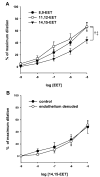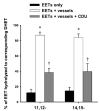Epoxyeicosatrienoic and dihydroxyeicosatrienoic acids dilate human coronary arterioles via BK(Ca) channels: implications for soluble epoxide hydrolase inhibition
- PMID: 16258029
- PMCID: PMC1456013
- DOI: 10.1152/ajpheart.00927.2005
Epoxyeicosatrienoic and dihydroxyeicosatrienoic acids dilate human coronary arterioles via BK(Ca) channels: implications for soluble epoxide hydrolase inhibition
Abstract
Epoxyeicosatrienoic acids (EETs) are metabolized by soluble epoxide hydrolase (sEH) to form dihydroxyeicosatrienoic acids (DHETs) and are putative endothelium-derived hyperpolarizing factors (EDHFs). EDHFs modulate microvascular tone; however, the chemical identity of EDHF in the human coronary microcirculation is not known. We examined the capacity of EETs, DHETs, and sEH inhibition to affect vasomotor tone in isolated human coronary arterioles (HCAs). HCAs from right atrial appendages were prepared for videomicroscopy and immunohistochemistry. In vessels preconstricted with endothelin-1, three EET regioisomers (8,9-, 11,12-, and 14,15-EET) each induced a concentration-dependent dilation that was sensitive to blockade of large-conductance Ca2+-activated K+ (BK(Ca)) channels by iberiotoxin. EET-induced dilation was not altered by endothelial denudation. 8,9-, 11,12-, and 14,15-DHET also dilated HCA via activation of BK(Ca) channels. Dilation was less with 8,9- and 14,15-DHET but was similar with 11,12-DHET, compared with the corresponding EETs. Immunohistochemistry revealed prominent expression of cytochrome P-450 (CYP450) 2C8, 2C9, and 2J2, enzymes that may produce EETs, as well as sEH, in HCA. Inhibition of sEH by 1-cyclohexyl-3-dodecylurea (CDU) enhanced dilation caused by 14,15-EET but reduced dilation observed with 11,12-EET. DHET production from exogenous EETs was reduced in vessels pretreated with CDU compared with control, as measured by liquid chromatography electrospray-ionization mass spectrometry. In conclusion, EETs and DHETs dilate HCA by activating BK(Ca) channels, supporting a role for EETs/DHETs as EDHFs in the human heart. CYP450s and sEH may be endogenous sources of these compounds, and sEH inhibition has the potential to alter myocardial perfusion, depending on which EETs are produced endogenously.
Figures





Similar articles
-
Soluble epoxide hydrolase contamination of specific catalase preparations inhibits epoxyeicosatrienoic acid vasodilation of rat renal arterioles.Am J Physiol Renal Physiol. 2011 Oct;301(4):F765-72. doi: 10.1152/ajprenal.00201.2011. Epub 2011 Jul 13. Am J Physiol Renal Physiol. 2011. PMID: 21753077 Free PMC article.
-
Epoxyeicosatrienoic acids and dihydroxyeicosatrienoic acids are potent vasodilators in the canine coronary microcirculation.Circ Res. 1998 Nov 2;83(9):932-9. doi: 10.1161/01.res.83.9.932. Circ Res. 1998. PMID: 9797342
-
EET homologs potently dilate coronary microvessels and activate BK(Ca) channels.Am J Physiol Heart Circ Physiol. 2001 Jun;280(6):H2430-40. doi: 10.1152/ajpheart.2001.280.6.H2430. Am J Physiol Heart Circ Physiol. 2001. PMID: 11356595
-
Reno-protective mechanisms of epoxyeicosatrienoic acids in cardiovascular disease.Am J Physiol Regul Integr Comp Physiol. 2012 Feb 1;302(3):R321-30. doi: 10.1152/ajpregu.00606.2011. Epub 2011 Nov 23. Am J Physiol Regul Integr Comp Physiol. 2012. PMID: 22116511 Review.
-
Arachidonic acid cytochrome P450 epoxygenase pathway.J Lipid Res. 2009 Apr;50 Suppl(Suppl):S52-6. doi: 10.1194/jlr.R800038-JLR200. Epub 2008 Oct 23. J Lipid Res. 2009. PMID: 18952572 Free PMC article. Review.
Cited by
-
Soluble epoxide hydrolase contamination of specific catalase preparations inhibits epoxyeicosatrienoic acid vasodilation of rat renal arterioles.Am J Physiol Renal Physiol. 2011 Oct;301(4):F765-72. doi: 10.1152/ajprenal.00201.2011. Epub 2011 Jul 13. Am J Physiol Renal Physiol. 2011. PMID: 21753077 Free PMC article.
-
Epoxyeicosatrienoic acids attenuating hypotonic-induced apoptosis of IMCD cells via γ-ENaC inhibition.PLoS One. 2014 Apr 8;9(4):e94400. doi: 10.1371/journal.pone.0094400. eCollection 2014. PLoS One. 2014. PMID: 24713619 Free PMC article.
-
Role of caveolae in shear stress-mediated endothelium-dependent dilation in coronary arteries.Cardiovasc Res. 2013 Oct 1;100(1):151-9. doi: 10.1093/cvr/cvt157. Epub 2013 Jun 19. Cardiovasc Res. 2013. PMID: 23787000 Free PMC article.
-
Alcohol produces distinct hepatic lipidome and eicosanoid signature in lean and obese.J Lipid Res. 2016 Jun;57(6):1017-28. doi: 10.1194/jlr.M066175. Epub 2016 Mar 28. J Lipid Res. 2016. PMID: 27020313 Free PMC article.
-
Inhibition of soluble epoxide hydrolase preserves cardiomyocytes: role of STAT3 signaling.Am J Physiol Heart Circ Physiol. 2010 Feb;298(2):H679-87. doi: 10.1152/ajpheart.00533.2009. Epub 2009 Dec 11. Am J Physiol Heart Circ Physiol. 2010. PMID: 20008276 Free PMC article.
References
-
- Archer SL, Gragasin FS, Wu X, Wang S, McMurtry S, Kim DH, Platonov M, Koshal A, Hashimoto K, Campbell WB, Falck JR, Michelakis ED. Endothelium-derived hyperpolarizing factor in human internal mammary artery is 11,12-epoxyeicosatrienoic acid and causes relaxation by activating smooth muscle BK (Ca) channels. Circulation. 2003;107:769–776. - PubMed
-
- Armstead WM. Role of activation of calcium-sensitive K+ channels in NO- and hypoxia-induced pial artery vasodilation. Am J Physiol Heart Circ Physiol. 1997;272:H1785–H1790. - PubMed
-
- Busse R, Edwards G, Feletou M, Fleming I, Vanhoutte PM, Weston AH. EDHF: bringing the concepts together. Trends Pharmacol Sci. 2002;23:374–380. - PubMed
-
- Campbell WB, Falck JR, Gauthier K. Role of epoxyeicosatrienoic acids as endothelium-derived hyperpolarizing factor in bovine coronary arteries. Med Sci Monit. 2001;7:578–584. - PubMed
Publication types
MeSH terms
Substances
Grants and funding
- R01 HL051055/HL/NHLBI NIH HHS/United States
- F32 ES005707/ES/NIEHS NIH HHS/United States
- HL-51055/HL/NHLBI NIH HHS/United States
- DK-38266/DK/NIDDK NIH HHS/United States
- R01 ES002710/ES/NIEHS NIH HHS/United States
- P30 ES005707/ES/NIEHS NIH HHS/United States
- P42 ES004699/ES/NIEHS NIH HHS/United States
- Intramural NIH HHS/United States
- ES-02710/ES/NIEHS NIH HHS/United States
- HL-68769/HL/NHLBI NIH HHS/United States
- ES-05707/ES/NIEHS NIH HHS/United States
- ES-04699/ES/NIEHS NIH HHS/United States
- P01 HL068769/HL/NHLBI NIH HHS/United States
- R37 ES002710/ES/NIEHS NIH HHS/United States
LinkOut - more resources
Full Text Sources
Miscellaneous

